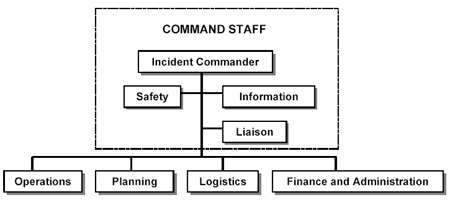Incident Command System (ICS) is an integrated and standardized on-scene management framework that allows an organization to quickly respond to emergencies situation (USDL). Develop in early 1970s. ICS has become an important tool for equipment, personnel, procedures, facilities and communication integration within a single organizational structure.
It represents best practices and has grown to become a standard for managing emergencies. ICS can also be used to manage planned events, acts of terrorism and natural disasters (FEMA). Because of its sophisticated nature that allows for rapid response, ICS is a key feature for National Incident Management System (FEMA).
Initially, ICS was developed as a management tool to respond to rapidly moving wildfires. According to United States Department of Labor (USDL), ICS was also developed to eliminate the problem of many people reporting to a single supervisor and the existence of unclear channels of authority (USDL).
Other problems that prompted the development of ICS were the lack of structured coordination among different agencies, insufficient and incompatible communication structure, and the lack of incident information that could be relied (USDL).
It is in the 1980s that ICS was integrated into a national outfit program called the National Interagency Incident Management Systems (NIIMS) thus becoming an incident response management system. Since then, ICS has become incident response tool used by many federal organizations and agencies to respond to disasters and emergencies(USDL).
By creating a manageable control system, ICS facilitates integrated planning and communication framework which an emergency response into five functional and manageable units that are critical emergency operations. These units are; Command, Operations, Planning, Logistics and Finance and Administration (USDL). The structure is as shown in Figure 1 below

Figure: ICS structure
Source: United States Department of Labor
Duties and responsibilities of Command Staff
At the top of the hierarchy is the Incident Commander (IC) who overseas the overall incident management operations besides developing goals and objectives of the incident response. The IC neither belongs to the Command nor General staff.
The IC unless he/she assigns duties to CS of GS, is responsible for establishing quick safety priorities in case of emergencies, and stabilizing the incident by availing cost effective and efficient ilfe saving resources, create incident objectives. Other responsibilities of IC include approving the implementation of Action Plan and ensuring that sufficient safety and health measures are available during emergencies (FEMA).
The Command Staff (CS) is responsible for carrying out staff functions which are essential in supporting the duties of an IC. These functions are incident safety, liaison, and public affairs.
The information Officer is tasked with developing and releasing incident information to the media, conducting press briefing, maintaining incident information, and availing to the incident personnel any incident information. The information officer also monitors and maintains any media information that can be used for incident planning (FEMA).
The Liaison Officer is responsible for coordinating incident activities between numerous agencies and IC. The duties include maintaining a list of agencies, establishing and coordinating interagency activities, and monitoring incident operations in order to identify potential problems (USDL).
The Safety officer on the other hand is tasked with developing and recommending health and safety measures to the IC. The Safety Officers role is to develop Site Safety Plan, evaluate Incident Safety Action and to provide quick and accurate hazards assessment and required safety measures (FEMA).
Duties and responsibilities of General Staff
The General staff include Planning, Logistics, Operations and Finance and Administration. Unlike Command Staff, General Staff are responsible for coordinating the functional operations of the ICS (FEMA). The Operation Staff manages all operations which are directly linked to the primary objective of the incident operation.
Their work is to manage and assure safety of operations, develop the operation part of Incident Action Plan (IAP), coordinate the execution of IAP portion and approve changes to the IAP. The Officer in charge of Operations section manages all technical and tactical incident operations as provided by the IAP (FEMA).
The Planning section collects, evaluates and disseminates tactical information relating to incident operations.The department also supervises IAP preparations, compiles incident information, assesses alternative strategies, and reports major changes in incident status among others (FEMA).
The officer in charge of planning sections overseas all planning activities for the incident response and coordinates the operation of planning section. The Logistics Staff avails services, materials and facilities for incident response operations.
These services and facilities include food, supplies, medical services, communications, and transportation services among other services that might be required emergency responders (FEMA). The Finance and Administrative department provides financial, cost analysis and administrative support for incident response (USDL).
Generally Incident Command System remains an effective tool for handling all sorts of disasters ranging from man made to catastrophic, small to complex disasters at all levels of organization (FEMA).
The Incident Action Plan (IAP) provides a framework that ensures inclusive communication aimed at achieving a common incident objective. If ICS is executed effectively, it remains the most effective and efficient tool for handling emergency situations.
Works Cited
FEMA, 2008. Incident Command System. pdf file. Web.
USDL.n.d Occupational Safety & Health Administration. n.d. Web.